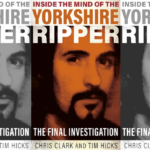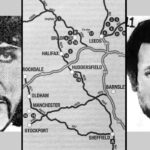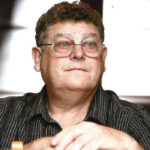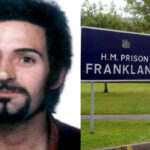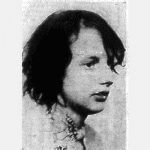“Yorkshire Ripper” Peter Sutcliffe died on the 13th of November 2020. He is unquestionably the UK’s most famous serial killer. He terrorised the North of England and ran rings around the police for years.
The Yorkshire Ripper investigation is undoubtedly the most important case in the history of policing in Yorkshire. Because of this and the impact it had on policing in Britain, we are giving this story extended coverage.
Tim Hicks and Chris Clark are now arguably the most knowledgeable journalists currently commenting on the case. In this article, they give an overview of Peter Sutcliffe’s crimes, assess the impact Sutcliffe had on people in the North of England at the time and the reason for the failures of the investigation. As a result of new witness evidence, they also reveal two new astonishing aspects of this case, never revealed before.
Peter Sutcliffe: Obituary & Assessment
by TIM HICKS & CHRIS CLARK
~~~~~
Personal foreword by Tim Hicks
I do not normally agree with obituaries for creatures like Peter Sutcliffe. My studies of the Kray twins lead me to fear that they may be seen to be glamourising them, or treating them as media or historical figures, when, in fact, they are vile, failed people. However, such is the importance and impact of Sutcliffe on Yorkshire at the time and on policing in the UK, that I think an assessment should be recorded on the occasion of his passing.
A number of obituaries have been written for Sutcliffe. In my view, they are much of a muchness, relying on standard extracts about Sutcliffe, written by journalists that were not around at the time, can’t remember the impact he had, who are not specialist crime reporters and just want to get off a few hundred words as quickly as possible to keep the editor happy. Most of them got the number of attacks wrong and do not tell the full story.
Chris and I do not want to go over the same old ground. We have decided on a different format, based on factual and analytical assessment with a tabular chronology.
Obituary: Peter William Sutcliffe.
Peter William Sutcliffe was born in Bingley in West Yorkshire on Sunday the 2nd of June 1946. His Father was a merchant seaman and mill worker. Peter Sutcliffe was unsuccessful at school and left at fifteen, with no qualifications. He was painfully shy with girls and had been bullied at school, leading him to take up bodybuilding.
Sutcliffe eventually obtained employment as a grave digger, where he mutilated the bodies and stole rings and jewellery from the corpses. This was the first manifestation of his homicidal tendencies.
In 1969, he attacked a prostitute in Bradford with a stone in a sock, accompanied by his friend Trevor Birdsall. He was arrested in Bradford later that year armed with a hammer and convicted of going equipped to steal. It is now clear that he intended to murder a woman. This is held out as his first attack, although the authors disagree with this assessment and believe he had been killing much earlier and was responsible for the murder of Fred Craven in Bingley, in 1966.
In 1971, he worked on the production line at Baird’s Television. He left in 1973 to work nightshifts as a furnace man at Anderton International from April 1973, until February 1975, when he took redundancy and used the redundancy compensation to finance HGV driver training.
Sutcliffe married teacher Sonia Szurma in 1974 and they moved to a house at 6 Garden Lane, Heaton, Bradford.
He had access to cars from 1963 onwards and enjoyed driving. He drove all over the UK both privately for pleasure, visiting relatives in London and Duxford. He was successful in obtaining work as an HGV driver, but was sacked for theft in March 1976. In October 1976, he was employed as an HGV driver for T. & W.H. Clark (Holdings) Ltd. in Bradford. He retained this job, driving an enormous Ford Transcontinental lorry all over the UK until his arrest in 1981.
In October 1975, Wilma McCann was found murdered and horrifically mutilated in Leeds. She was swiftly followed by others and the police slowly realised they were dealing with a serial killer. Anyone who was not alive at the time and living in Yorkshire cannot conceive of the mood of terror and threat in the North the time. Women were terrified, particularly when it became clear that he was not confining his attacks to prostitutes, or to Yorkshire. One of his victims, Tracey Brown (pictured above in the lead illustration), who was fourteen when Sutcliffe attacked, her describes her terrible injuries and the way he terrorised Yorkshire here.
Understandably, women were outraged by the failure of the police to arrest the ripper, and the police advice to stay in. The “Leeds Revolutionary Feminist Group” organised a number of demonstrations of women demanding that men be kept off the streets. Women were carrying weapons and being arrested by the police, and men were being attacked by women convinced they were the Ripper. Some women approached prostitutes and asked them to stop selling themselves which in turn led to violent confrontations with their pimps. This is covered very well at 29 minutes and 1.15 in this presentation by retired Inspector Tony Davies of the Manningham Division of West Yorkshire Police, which covered the Bradford ‘red light’ district.
Sutcliffe was arrested in 1981 in Sheffield for car theft, because he was in a car with false number plates in the company of prostitute Olivia Rievers. Under interrogation, he admitted being the Yorkshire Ripper.
His defence of insanity was rejected and he was convicted of thirteen murders and seven attempted murders in May 1981. He was sentenced to life imprisonment with a minimum term of 30 years. Theoretically this could have resulted in his release in 2011, but the High Court imposed a whole life tariff.
In March 1984, Sutcliffe was sectioned and sent to Broadmoor Secure Psychiatric Hospital. He separated from his wife Sonia in 1989. They divorced in 1994.
He was attacked by another patient in 1997, losing the sight in his left eye. His right eye was severely damaged.
Sutcliffe was returned from Broadmoor to the prison system in August 2016. He died on the 13th of November 2020 in the University Hospital of North Durham with COVID-19 while serving a full life term at HMP Frankland. He had developed diabetes in 2003, had been ill for some time and was receiving hospital treatment for his failing eyesight.
Peter William Sutcliffe. Serial killer. Born 2 June 1946; died 13 November 2020.
Tim Hicks and Chris Clark
Assessment: Number of victims
Sutcliffe was convicted of thirteen murders and seven attempted murders, making a total of twenty attacks.
In addition, he was cautioned for the attempted murder of a prostitute in 1969, but not charged because his victim did not want to press charges.
No charges were preferred against him for the attempted murder of Olivier Reivers in 1981 in Sheffield, because the police arrested him before he could attack her.
After his trial, Sutcliffe admitted two other attempted murders (Tracey Browne and Ann Rooney).
In 2010, he appealed the whole life tariff and West Yorkshire Police issued a statement that if he was to be released, he would be immediately charged with another murder (Debra Schlesinger) and another attempted murder (Maureen Lea), to ensure he stayed in prison for life. Poor Debra Schlesinger has never been acknowledged by the media as one of his victims and all of the obituaries I have seen excluded mention of her.
This makes a total of twenty-six attacks, fourteen murders and twelve attempted murders, as shown in Table 1, below.
Whenever a serial killer is arrested, the police perform an antecedent investigation to assess the full range of crimes he may have committed. There were three antecedent investigations into Sutcliffe by Assistant Chief Constable (ACC) Colin Sampson, ACC Keith Hellawell and Chief Constable Sir Lawrence Byford (NYE coverage here). Such is the controversy over the Yorkshire Ripper that they have never been fully released.
Sir Lawrence Byford found:
“We feel it is improbable that the crimes in respect of which Sutcliffe has been charged and convicted are the only ones attributable to him.
It is my firm conclusion that between 1969 and 1980 Sutcliffe was probably responsible for many attacks on women, which he has not admitted, not only in West Yorkshire and Manchester but also in other parts of the country….”
Sir Lawrence Byford identified thirteen attacks committed by Sutcliffe, ACC Hellawell identified an additional nine attacks.
The full list is shown in Table 2, below.
Table 1 shows confirmed attacks and Table 2 attacks assessed by the police as having been perpetrated by Peter Sutcliffe
This makes a total of forty-five attacks, not the twenty generally credited in the media.
The authors would emphasise that these figures are based on official police assessments, not the work of the authors or other journalists.
Sutcliffe was undoubtedly guilty of many more attacks. A detailed chronology of Sutcliffe’s life can be seen in tabular format below, specifying the full range of attacks the authors believe he was responsible for.
Assessment: How was he able to evade detection for so long?
In the authors view there are a number of reasons for this:
- Peter Sutcliffe’s skill and cunning
Peter Sutcliffe was a very capable criminal:
- He had an interest in body building since he was a youth. This enabled him to strike with great force and move bodies out of sight quickly. He was able to easily throw fourteen year old Tracey Brown over a high fence to escape being seen by a passing motorist. He kept fit and was able to outrun pursuers.
- He changed cars frequently, used other people’s cars on occasion and used false number plates. This was to be his undoing when two policemen spotted his car had false plates in Sheffield in 1981.
- He varied his modus operandi by using various types of hammer, screwdrivers, knives and a ligature, to prevent them linking his crimes.
- He used weapons like hammers and screwdrivers that appeared innocent if he was caught with them. Hence the reason he was only charged with going equipped to steal when found with a hammer and knife in Bradford’s red light district in 1969.
- He sometimes concealed bodies to obscure the date of death and make it difficult for police to break his alibi. He also planted a post-dated item on at least one body for the same reason.
- He was forensically aware, never left a weapon, fingerprint or possession at a crime scene and burnt his clothing in a garden incinerator. The only exception to this was when he left a new five pound note in the handbag of one of his victims, which was nearly traced back to him via the serial number. When he was arrested in 1981, he hid his weapons behind an oil tank while pretending to urinate. He hid another weapon in the toilet cistern in the police station.
- He varied his appearance, sometimes having long thick hair, sometimes short, variously having a full beard, moustache and beard, or side burns (see photo fits and photograph above). He had swarthy skin and afro hair, so at night he was sometimes mistaken for being black. This led to a plethora of photo fits which the police were unable to link.
- West Yorkshire is a series of urban centres with red light districts, interconnected by a motorway network giving access to Sheffield and Manchester. He attacked where there was a fast exit to a motorway or an A Road. Sutcliffe struck, left the scene quickly and used the road network to make his escape home.
- He led a quiet life appearing to be a hardworking, married man in stable employment and did not draw attention to himself.
- He and Sonia did not go out much, so when questioned, Sonia would always stay that they stayed in most nights, so he was probably at home. Not a strong alibi, but strong enough.
- He did not confide in anyone, so no one could inform on him.
- He was quiet spoken, neat and tidy, with a local accent, which put people at their ease and made it easy for him to pick up victims.
- Sutcliffe was questioned nine times by different detectives, but was calm and controlled, so he did not break under the strain of being questioned.
- Failures endemic to all forces in the UK in the 1960’s and 1970’s
- Failure of individual police forces to cooperate: Prior to the Yorkshire Ripper investigation, there was an equally disastrous multi force investigation into serial killer Donald Nielson, who was known as the “Black Panther”. He was a prolific and highly skilled burglar who also robbed Post Offices. Coincidentally, Chris Clark investigated two of his burglaries in Kings Lynn. In 1974 Nielson murdered postmasters in Harrogate (North Yorkshire Police) Baxenden (Lancashire Police) and Langley (West Midlands Police). In 1975 he kidnapped heiress Lesley Whittle in Highley, Shropshire (West Mercia Police), shot a security guard in Dudley (West Midlands Police) and murdered Lesley Whittle at Kidsgrove (Staffordshire Police). The police operation to free her was catastrophically bungled because none of these forces would work together. The Home Secretary assured the House of Commons that the police had been reformed and this could never happen again. Although in fact it did in the ripper investigation. Please see this presentation here by former West Yorkshire Detective Constable Ray Tough who served on the Ripper Enquiry. At 14.09 and confirms that West Yorkshire Metropolitan Police and Greater Manchester Police did not exchange information on the ripper investigation and there were clashes between the ACCs leading the two force investigations. Inspector Tony Davies also confirms this at 41.44 here. To quote Chief Constable Byford:
“Regretfully, some of these lessons were previously identified at the conclusion of the “Black Panther” case in 1975 but, in the light of the Ripper case, quite clearly the Police Service has not learned from them, particularly those relating to the management and control of a multi-force murder investigation.”
- Failure to standardise police procedures: In the 1960’s, there were about 500 police forces in England and Wales and these were systematically amalgamated into the large forces we know today. Prior to the amalgamations all major enquiries were run by Scotland Yard, which would send a Detective Superintendent to run the investigation and an experienced Detective Sergeant to run the incident room, so all investigation procedures were standardised by Scotland Yard. The mergers created larger forces with large teams of detectives that could handle major investigations without Scotland Yard. So inevitably they changed their force procedures, thereby abandoning the nationally standardised Scotland Yard procedures. Consequently, multi force investigations were hampered because officers from different forces used non-standard processes.
- Failure to establish a centralised intelligence system: When a criminal was convicted, the arresting force would raise two card indexes. One would be retained, the other would be held centrally in Scotland Yard. The card for Sutcliffe sent to Scotland Yard in 1969 recorded his arrested for possession of a hammer and a knife in the red light district in Bradford and conviction for going equipped to steal. The card retained by Bradford City Police in Bradford did not mention the weapons. So when the Leeds detectives looked at it, it did not arouse their suspicions. The Scotland Yard card with the critical information was not available to them, nor were the cards held by Greater Manchester Police in their card index system.
- Inability to process the vast amount of data the investigation created: The Ripper investigation was the largest investigation in the history of the police service. It generated thousands of statements, suspects, house visits and vehicle sightings. This was in the days before computers, so it all had to be transcribed onto card indexes. Other than possibly Scotland Yard, no UK police force had the experience to process, store and access that amount of card indexed data.
- Issues specific to the Ripper investigation
There is very little doubt that most forces faced with an investigation of this magnitude would have failed. There were however specific factors relating to West Yorkshire Metropolitan Police and the investigation team, which are set out below:
- Divisions within West Yorkshire Metropolitan Police: In 1968 the West Riding Constabulary was merged with the six borough forces for the county boroughs of Barnsley (Barnsley Borough Police), Dewsbury (Dewsbury Borough Police), Doncaster (Doncaster Borough Police), Halifax (Halifax Borough Police), Huddersfield (Huddersfield Borough Police), and Wakefield (Wakefield City Police) into West Yorkshire Constabulary. Bradford City Police and Leeds City Police remained as independent police forces, the Sheffield and Rotherham Borough Police forces merged into the Sheffield and Rotherham Constabulary remaining independent until 1974, when West Yorkshire Constabulary was re-organised to incorporate Bradford City Police and Leeds City Police and renamed West Yorkshire Metropolitan Police. It was a force joined at the top and was not integrated. The individual city divisions did not talk to each other or share information and still acted as if they were individual independent forces. It did not have a centralised intelligence system, the intelligence was held in individual city divisions, which resisted centralised recording and sharing of information. Each murder had a separate card index system which was not cross referenced to the others. The reality was that it could not conduct an investigation into linked offences committed in multiple locations.
- Failure of force leadership: Chief Constable Gregory was not capable of handling an investigation of this size and complexity. He did not have a CID background and made his reputation on his management of the force mergers noted above. He failed to bring in new leadership when it became obvious the investigation was failing. Eventually Sir Lawrence Byford had him and the other senior officers replaced. He was retired two years later and sold his story to the papers for £40,000.
- Failure of CID leadership: Neither ACC Oldfield or his second in command D/Supt Holland were competent detectives or capable of handling an investigation of this size and complexity. Oldfield made his reputation from his incompetent investigation of the murder of twelve people by the IRA in the M62 coach bombing. He convicted a mentally ill former soldier who was later acquitted. The IRA gang was never arrested. He was appointed because of his seniority, not his capability as a detective. His health was failing, the brutality of the murders had deeply affected him and he had become personally involved to the point where his judgment had become unsound. D/Supt Holland was also a member of the M62 coach investigation and played a major role in the notorious conviction of Stefan Kiszko for murder, who was also innocent. Holland had a dominant personality, which resulted in valid lines of enquiry suggested by junior officers being ignored. When Detective Constable Laptew suggested that Sutcliffe should be arrested, Holland prohibited it because Sutcliffe did not have a Geordie accent and threatened to put him back on the beat.
- Failure of incident room management: To quote Byford: “The ineffectiveness of the major incident room was a serious handicap to the Ripper investigation. While it should have been the effective nerve centre of the whole police operation, the backlog of unprocessed information resulted in the failure to connect vital pieces of related information. This serious fault in the central index system allowed Peter Sutcliffe to continually slip through the net“. As an example, one of the best leads occurred when Sutcliffe’s associate Trevor Birdsall, who had witnessed Sutcliffe’s 1969 attack on a prostitute wrote to the police denouncing him as the Ripper. Birdsall also visited the police station and made this allegation to a detective who raised a report. The letter and assessment of it were not filed in the system and the report of Birdsall’s allegations was lost. Effectively preventing Sutcliffe’s arrest.
- Individual investigative failures within the enquiry:
- Although initially bungled by faulty analysis and rivalry between WYP and GMP, the tyre impressions Sutcliffe left at the Irene Richardson, Marilyn Moore and Vera Millward crime scenes could have led to his identification. However, this line of enquiry was abandoned more than halfway through due to lack of resources.
- Detectives did not identify that some victims were victims of Sutcliffe, because they were not prostitutes.
- Early fotofit impressions of the murderer were ignored and not linked (see lead illustration) although they were all very similar.
- The investigation team fell for a hoax involving three letters and a tape sent by hoaxer John Humble who alleged that he was the ripper, had murdered Joan Harrison in Preston in November 1975 and would attack next in Manchester or Bradford. This this was release to the public by ACC Oldfield at a press conference in June 1979. For two years the investigation team pursued Humble and announced that the Yorkshire Ripper had a Geordie accent. This was despite multiple victims saying the ripper had a local accent and against the advice of police voice experts Stanley Ellis and Jack Windsor-Lewis. In this BBC documentary at 35 they state that they said the tapes were a hoax and they were ignored. At 43 Detective Inspector Zackrisson, suggests Sutcliffe chose Bradford for his attack on Barbara Leach on the 2nd of September 1979 to mislead the investigation into focussing on the unknown Geordie, by fulfilling the threats made by Humble in the letters of a Bradford attack and in the tape of an attack in September or October. The authors find this entirely credible. In addition, we can now reveal that a new witness has come forward to the NYE with two sightings of Sutcliffe in Winckley Square Preston which is about seven minutes’ drive from Berwick Street where Joan Harrison was murdered in October 1980. The authors believe that Sutcliffe chose Preston to give credence to the allegations made in the hoax letters that the attack on Joan Harrison was a ripper attack. Thereby directing it towards the letter writer as the main suspect. In short, it is now clear that Sutcliffe was following a strategy of tailoring his attacks to manipulate the investigation and decoy it into investigating Humble and the North East. Thereby distracting it from effectively investigating him. He was successful in this and gained more time before he was eventually arrested. He himself confirmed the hoax was a diversion that helped him carry on.
- The Charlesworth Criteria: All forces were circularised and asked to consider if they had any crimes that had been committed by the Yorkshire Ripper. Criteria were drawn up by Superintendent Charlesworth to assist them to identify ripper attacks. However, Sir Lawrence Byford assessed they were “very restrictive” and their application had resulted in the elimination of a number of attacks which had in fact been perpetrated by Sutcliffe.
- Sexist attitudes amongst West Yorkshire Police: The police were disdainful of prostitutes and only started to investigate the attacks seriously when “innocent” women were murdered. Victims who described a man with a local accent had their accounts dismissed by the police. One victim who came in to see the police was told “We are all having fun and games today, aren’t we?”. Excellent Guardian article covering this aspect of the investigation here. West Yorkshire Police Chief Constable Robins apology for the way victims were treated can be read here.

Left to Right: ACC George Oldfield, who initially led the investigation and died prematurely as a result of the strain of the Ripper investigation; Chief Constable Ron Gregory; Detective Superintendent Jim Hobson, who was to lead the investigation after Oldfield.
- Failure of Media Strategy: ACC Oldfield distrusted the media and did not want to release information to them, ensuring that the media were not properly briefed and integrated into the investigation.
- Policy of supressing reports of Ripper attacks: Such was the criticism and pressure on West Yorkshire Metropolitan Police that the Chief Constable directed that attacks which were obviously perpetrated by the Yorkshire Ripper should not be acknowledged as such. Detective Chief Superintendent John Stainthorpe confirmed that he had been ordered not to record the attempted murder of Yvonne Mysliwiec at Ilkley in 1979 as a Ripper attack, although it obviously was (NYE coverage here).
- Now in a stunning development, retired Inspector Megan Winterbotham, has come forward confirming that there were other victims who have not been recognised. Chief Constable Gregory ordered her not to recognise an attack on a woman as being perpetrated by Sutcliffe, because he felt that West Yorkshire Police had enough on its plate, although it clearly was a Ripper attack. See her comments at 2.10 here. In short, the Chief Constable was following a policy of media manipulation by supressing reports of Ripper attacks, to prevent further criticism of himself and his force.
Assessment: Sutcliffe’s impact on policing
Sir Lawrence Byford’s report on the failure of the Yorkshire Ripper investigation led to the to the introduction of a standardised cross referenced index card system across all forces in 1983 and the Association of Chief Police Officers (ACPO) standard manual procedures in 1984. This included standardisation of card index systems across all forces and then the implementation of the HOLMES (Home Office Large Major Enquiry System) which revolutionised policing. Thereby preventing the information overload that destroyed the Yorkshire Ripper enquiry.
The training of senior officers in running large multi force investigations was also improved.
Sir Lawrence oversaw these improvements, which are still present in the British Police Service today, which is much improved as a result of the failure of the Yorkshire Ripper investigation.
Following the Black Panther fiasco, it took a disaster of the size of the Yorkshire Ripper investigation to force the police to acknowledge its failings and improve.
Debra Schlesinger and the other ignored victims
When the full scale of the police failure became known, there was a furore of criticism of the police, with calls for a national police force and for every Chief Officer of West Yorkshire Police to be sacked. Hence no doubt the reason that Chief Constable Gregory followed a policy of not admitting to the real number of victims.
Needless to say, no Chief Constable wanted his force to be associated in any way with this failed and controversial investigation. Nor did they want to expend resources on investigating the crimes of a man that was primarily seen as a West Yorkshire Police problem who was in prison for life. So this, coupled with the impact of the Charlesworth Criteria prevented the identification of all of Sutcliffe’s crimes, as more information came out.
According to this BBC Report, in 2016 detectives from West Yorkshire Police interviewed Sutcliffe in prison about 17 unsolved cases. Even now, the full police assessments of his crimes have not been fully released and it is unclear how many victims he had.
Retired Police Intelligence Officer Chris Clark has nevertheless continued to pursue the investigation into the full range of Sutcliffe’s crimes, in conjunction with the NYE.
The chronology above includes all of the murders and attempted murders Chris believes Sutcliffe should be a suspect for. He is currently lobbying the Prime Minister and the National Crime Agency to conduct a full review of Sutcliffe’s crimes.
In another first for the NYE, this aspect of Sutcliffe’s offending has now been covered in the national press. Sunday Mirror article here.
The NYE will continue to try and raise the issue of the unacknowledged victims to try and obtain some final credible assessment of Sutcliffe’s crimes, justice for the victims and closure for their families.





